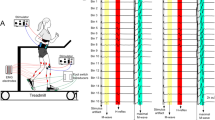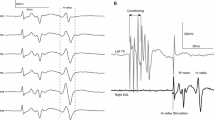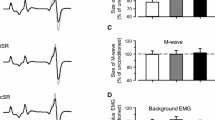Abstract
During locomotion spinal short latency reflexes are rhythmically modulated and depressed compared to rest. In adults this modulation is severely disturbed after bilateral spinal lesions indicating a role for supra-spinal control. Soleus reflex amplitudes are large in the stance phase and suppressed in the swing phase contributing to the reciprocal muscle activation pattern required for walking. In early childhood the EMG pattern during gait underlies an age-dependent process changing from co-contraction of agonists and antagonists to a reciprocal pattern at the age of 5–7 years. It is unknown whether at this stage apart from the EMG also reflexes are modulated, and if so, whether the reflex modulation is fully mature or still underlies an age-dependent development. This may give important information about the maturation of CNS structures involved in gait control. Soleus Hoffmann H-reflexes were investigated in 36 healthy children aged 7–16 years during treadmill walking at 1.2 km/h and 3.0 km/h. At 7 years old a rhythmic modulation similar to adults was observed. The H-reflex size during the stance phase decreased significantly with age while the maximum H-reflex (H max) at rest remained unchanged. At 3.0 km/h H-reflexes were significantly larger during the stance phase and smaller during the swing phase as compared to 1.2 km/h but the age-dependent suppression was observed at both walking velocities. In conclusion H-reflex modulation during gait is already present in young children but still underlies an age-dependent process independent of the walking velocity. The finding that the rhythmic part of the modulation is already present at the age of 7 years may indicate that the supra-spinal structures involved mature earlier than those involved in the tonic reflex depression. This may reflect an increasing supra-spinal control of spinal reflexes under functional conditions with maturation.



Similar content being viewed by others
References
Beres-Jones JA, Harkema SJ (2004) The human spinal cord interprets velocity-dependent afferent input during stepping. Brain 127:2232–2246
Berger W, Altenmüller E, Dietz V (1984) Normal and impaired development of children’s gait. Hum Neurobiol 3:163–170
Berger W, Quintern J, Dietz V (1985) Stance and gait perturbations in children: developmental aspects of compensatory mechanisms. Electroencephalogr Clin Neurophysiol 61:385–395
Berger W, Quintern J, Dietz V (1987) Afferent and efferent control of stance and gait: developmental changes in children. Electroencephalogr Clin Neurophysiol 66:244–252
Berger W, Horstmann GA, Dietz V (1990) Interlimb coordination of stance in children: divergent modulation of spinal reflex responses and cerebral evoked potentials in terms of age. Neurosci Lett 116:118–122
Brooke JD, Collins DF, Boucher S, McIlroy WE (1991) Modulation of human short latency reflexes between standing and walking. Brain Res 548:172–178
Brooke JD, McIlroy WE, Collins DF (1992) Movement features and H-reflex modulation. I. Pedalling versus matched controls. Brain Res 582:78–84
Capaday C, Stein RB (1986) Amplitude of the soleus H-reflex in the human during walking and standing. J Neurosci 6:1308–1313
Capaday C, Stein RB (1987) Differences in the amplitude of the human soleus H reflex during walking and running. J Physiol (Lond) 392:513–522
Chalmers GR, Knutzen KM (2000) Soleus Hoffmann-reflex modulation during walking in healthy elderly and young adults. J Gerontol A Biol Sci Med Sci 55:B570–579
Crone C, Hultborn H, Mazieres L, Morin C, Nielsen J, Pierrot-Deseilligny E. (1990) Sensitivity of monosynaptic test reflexes to facilitation and inhibition as a function of the test reflex size: a study in man and the cat. Exp Brain Res 81:35–45
Dietz V, Quintern J, Berger W (1985) Afferent control of human stance and gait: evidence for blocking of group I afferents during gait. Exp Brain Res 61:153–163
Dietz V, Faist M, Pierrot-Deseilligny E (1990a) Amplitude modulation of the quadriceps H-reflex in the human during the early stance phase of gait. Exp Brain Res 79:221–224
Dietz V, Discher M, Faist M, Trippel M (1990b) Amplitude modulation of the human quadriceps tendon jerk reflex during gait. Exp Brain Res 82:211–213
Edamura M, Yang JF, Stein RB (1991) Factors that determine the magnitude and time course of human H-reflexes in locomotion. J Neurosci 11:420–427
Faist M, Dietz V, Pierrot-Deseilligny E (1996) Modulation, probably presynaptic in origin, of monosynaptic Ia excitation during human gait. Exp Brain Res 109:441–449
Faist M, Blahak C, Duysens J, Berger W (1999a) Modulation of the biceps femoris tendon jerk reflex during human locomotion. Exp Brain Res 125:265–270
Faist M, Ertel M, Berger W, Dietz V (1999b) Impaired modulation of the quadriceps tendon jerk reflex during spastic gait: differences between spinal and cerebral lesions. Brain 122:567–579
Forssberg H, Wallberg H (1980) Infant locomotion: a preliminary movement and electromyographic study. In: Berg K, Eriksson BO (eds) Children and exercise. IX International Series on Sport Science, vol 10, University Park Press, Baltimore, pp 32–40
Katz R, Meunier S, Pierrot-Deseilligny E (1988) Changes in presynaptic inhibition of Ia fibres in man while standing. Brain 111:417–437
Koceja DM, Markus CA, Trimble MH (1995) Postural modulation of the soleus H reflex in young and old subjects. Electroenceph Clin Neurophysiol 97:387–393
Lavoie BA, Devanne H, Capaday C (1997) Differential control of reciprocal inhibition during walking versus postural and voluntary motor tasks in humans. J Neurophysiol 78:429–438
Llewelyn M, Prochazka A, Vincent S (1987) Transmission of human tendon jerk reflexes during stance and gait. J Physiol 382:82
Morin C, Katz R, Mazieres L, Pierrot-Deseilligny E (1982) Comparison of soleus H reflex facilitation at the onset of soleus contraction produced voluntarily and during the stance phase of human gait. Neurosci Lett 33:47–53
Morita H, Shindo M, Yanagawa S, Yoshida T, Momoi H, Yanagisawa N (1995) Progressive decrease in heteronymous monosynaptic Ia facilitation with human ageing. Exp Brain Res 104:167–170
Morita H, Petersen N, Christensen LOD, Sinkjaer T, Nielsen J (1998) Sensitivity of H-reflexes and stretch reflexes to presynaptic inhibition in humans. J Neurophysiol 80:610–620
Mrachacz-Kersting N, Lavoie BA, Andersen JB, Sinkjaer T (2004) Characterisation of the quadriceps stretch reflex during the transition from swing to stance phase of human walking. Exp Brain Res 159:108–122
Mueller K, Hoemberg V, Lenard HG (1991) Magnetic stimulation of motor cortex and nerve roots in children. Maturation of cortico-motoneuronal projections. Electroenceph Clin Neurophysiol 81:63–70
Paus T, Zijdenbos A, Woresly K, Collins DL, Blumenthal J, Giedd JN, Rapoport JL, Evans AC (1999) Structural maturation of neural pathways in children and adolescents: in vivo study. Science 238:1908–1911
Petersen N, Morita H, Nielsen J (1999) Modulation of reciprocal inhibition between ankle extensors and flexors during walking in man. J Physiol (Lond) 520:605–619
Simonsen EB, Dyhre-Poulsen P (1999) Amplitude of the human soleus H reflex during walking and running. J Physiol (Lond) 515:929–939
Sinkjaer T, Andersen JB, Larsen B (1996) Soleus stretch reflex modulation during gait in humans. J Neurophysiol 76:1112–1120
Sinkjaer T (1997) Muscle, reflex and central components in the control of the ankle joint in healthy and spastic man. Acta Neurol Scand Suppl 170:1–28
Yang JF, Stein RB, James KB (1991) Contribution of peripheral afferents to the activation of the soleus muscle during walking in humans. Exp Brain Res 87:679–687
Yang JF, Whelan PJ (1993) Neural mechanisms that contribute to cyclical modulation of the soleus H-reflex in walking in humans. Exp Brain Res 95:547–556
Acknowledgments
The authors wish to express their gratitude to all children for participating in this study. This work was supported by a grant from the Deutsche Forschungsgemeinschaft, Be 936/4-1.
Author information
Authors and Affiliations
Corresponding author
Rights and permissions
About this article
Cite this article
Hodapp, M., Klisch, C., Berger, W. et al. Modulation of soleus H-reflexes during gait in healthy children. Exp Brain Res 178, 252–260 (2007). https://doi.org/10.1007/s00221-006-0730-1
Received:
Accepted:
Published:
Issue Date:
DOI: https://doi.org/10.1007/s00221-006-0730-1




